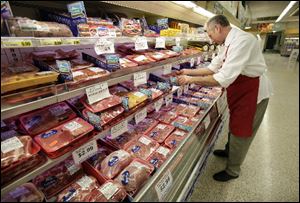
Goods, services cool in March
Food, fuel price surges not likely to cause inflation spike
4/16/2011
Consumers paid more for food and fuel in March, but Fed Chairman Benjamin S. Bernanke said he did not believe the surge would touch off rampant inflation. Because of the increases in food and fuel, Americans are spending less on discretionary goods and services.
WASHINGTON -- Price gains for U.S. goods and services other than food and fuel unexpectedly cooled in March, supporting Federal Reserve Chairman Benjamin S. Bernanke's view that the surge in commodity costs will not cause inflation to flare.
The Consumer Price Index rose 0.5 percent in March, the Labor Department said Friday.
That matched February's increase, the largest since the recession ended in June, 2009. In the last 12 months, the index has increased 2.7 percent, the biggest rise since December, 2009.
Excluding the volatile food and gas categories, the so-called core index rose 0.1 percent and it is up only 1.2 percent in the last year.
Consumers are spending more, but the steep rise in food and gas prices could limit their ability to purchase discretionary goods and services. Consumer spending makes up 70 percent of economic activity.
Rising inflation has caused many analysts to reduce their estimates for economic growth in the January-March quarter from roughly 3 percent or higher to as low as 1.5 percent.
Food prices rose 0.8 percent last month, the largest increase in almost three years. Prices for fruits and vegetables, dairy products, chicken, and beef all increased. Coffee costs rose 3.5 percent.
Separately, the Federal Reserve said U.S. factories produced more consumer goods, business equipment, and raw materials in March, boosting manufacturing activity for the ninth consecutive month.
Overall industrial production increased 0.8 percent.
Factory production, the largest single segment of industrial production, increased 0.7 percent last month. Manufacturing has been a key driver of economic growth since the recession ended. That continued last month, even with supply-chain disruptions stemming from the crisis in Japan.